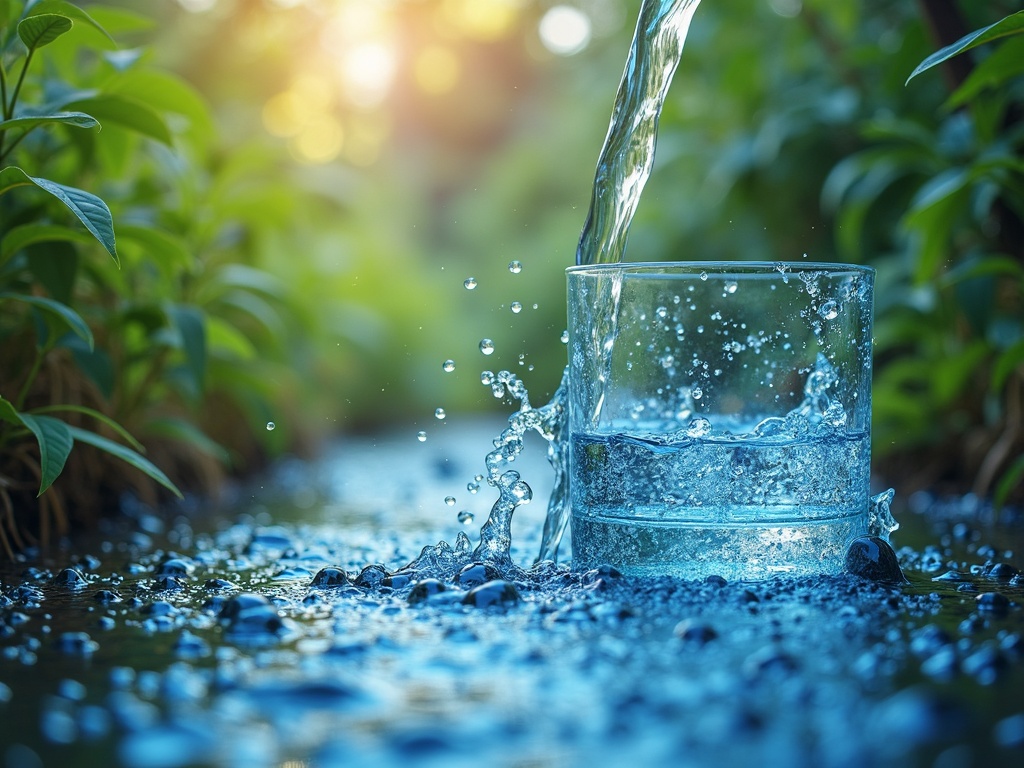Treating Rainwater with Bleach: A Comprehensive Guide
Imagine a world where the simple act of collecting rainwater can provide a safe and sustainable source of drinking water. While rainwater harvesting offers numerous benefits, ensuring its purity is paramount. One common method for disinfecting rainwater is the use of household bleach. But how much bleach is needed? Is it safe? This comprehensive guide will explore the science, safety, and best practices of treating rainwater with bleach, empowering you to make informed decisions about your water source.
The Basics of Rainwater Harvesting
Rainwater harvesting is the process of collecting and storing rainwater for later use. It's an ancient practice that's experiencing a modern resurgence due to increasing water scarcity, environmental concerns, and a desire for self-sufficiency. Rainwater can be used for a variety of purposes, including:
- Irrigation: Watering gardens, lawns, and agricultural crops.
- Toilet Flushing: Reducing the demand on potable water sources.
- Laundry: Saving water and energy with soft, chemical-free rainwater.
- Household Cleaning: Utilizing a readily available water source for various cleaning tasks.
- Drinking Water: After proper treatment and disinfection.
Why Treat Rainwater?
While rainwater is naturally soft and free of many chemicals found in municipal water supplies, it's not inherently sterile. As it falls through the atmosphere and flows across rooftops, it can pick up contaminants such as:
- Bacteria: From bird droppings, animal waste, and decaying organic matter.
- Viruses: Though less common than bacteria, viruses can also contaminate rainwater.
- Parasites: Such as Giardia and Cryptosporidium, which can cause gastrointestinal illness.
- Chemicals: From roofing materials, gutters, and atmospheric pollution.
- Debris: Leaves, twigs, dust, and other particulate matter.
Therefore, treating rainwater is crucial to ensure that it's safe for consumption and other uses that require high water quality.
Understanding Disinfection with Bleach
Bleach, specifically household bleach containing sodium hypochlorite (NaClO), is a powerful disinfectant that can effectively kill or inactivate many harmful microorganisms in water. It works by oxidizing the organic molecules within these microorganisms, disrupting their cellular processes and rendering them harmless.
How Bleach Works as a Disinfectant
Sodium hypochlorite breaks down in water to form hypochlorous acid (HOCl) and hypochlorite ion (OCl-). Hypochlorous acid is the more potent disinfectant, as it can easily penetrate the cell walls of microorganisms. The effectiveness of bleach depends on several factors:
- Concentration: The amount of available chlorine in the bleach solution.
- Contact Time: The duration for which the bleach is in contact with the water.
- pH Level: Hypochlorous acid is more effective at lower pH levels (acidic conditions).
- Temperature: Higher temperatures generally increase the reaction rate.
- Organic Matter: The presence of organic matter can reduce the effectiveness of bleach, as it consumes the chlorine.
Types of Bleach: What to Use and What to Avoid
Not all bleach products are created equal. When treating rainwater, it's essential to use the right type of bleach and avoid potentially harmful additives.
- Recommended: Plain, unscented household bleach containing 5.25% or 6% sodium hypochlorite. These are commonly available and effective for water disinfection.
- Avoid:
- Scented Bleach: Contains additives that can be harmful and leave unwanted tastes or odors in the water.
- Color-Safe Bleach: Usually contains hydrogen peroxide or other bleaching agents that are not suitable for water disinfection.
- Splash-less Bleach: Often contains thickening agents that can leave a residue in the water.
- Ultra Bleach: May have a higher concentration of sodium hypochlorite, requiring careful dosage adjustments. Always check the label and adjust accordingly.
Always check the label of the bleach to ensure it contains only sodium hypochlorite and is suitable for disinfection purposes.
Calculating the Correct Bleach Dosage
Determining the appropriate amount of bleach to add to rainwater is crucial for effective disinfection without creating harmful byproducts or leaving an unpleasant taste. The required dosage depends on the concentration of the bleach and the volume of water being treated.
General Dosage Guidelines
The following guidelines are based on using regular household bleach containing 5.25% sodium hypochlorite. If using bleach with a different concentration, adjust the dosage accordingly.
Important Note: These are general guidelines. Always test your water after treatment to ensure proper disinfection and chlorine residual (more on this later).
| Water Volume | Bleach Dosage (5.25% Sodium Hypochlorite) |
|---|---|
| 1 Gallon (3.785 Liters) | 8 drops (approximately 0.5 ml) |
| 5 Gallons (18.9 Liters) | 1/2 teaspoon (approximately 2.5 ml) |
| 10 Gallons (37.9 Liters) | 1 teaspoon (approximately 5 ml) |
| 50 Gallons (189 Liters) | 1/2 tablespoon (approximately 7.5 ml) |
| 100 Gallons (379 Liters) | 1 tablespoon (approximately 15 ml) |
Step-by-Step Instructions for Treating Rainwater with Bleach
Follow these steps carefully to ensure proper disinfection of your rainwater:
- Calculate the Water Volume: Accurately determine the volume of water you need to treat. This is crucial for accurate dosage.
- Determine Bleach Concentration: Check the label of your bleach to determine the percentage of sodium hypochlorite. Adjust the dosage accordingly if it's different from 5.25%.
- Add Bleach to Water: Using a clean dropper or measuring spoon, carefully add the calculated amount of bleach to the water.
- Mix Thoroughly: Stir the water vigorously for several minutes to ensure the bleach is evenly distributed.
- Wait for Contact Time: Allow the treated water to sit for at least 30 minutes before using it. This contact time is necessary for the bleach to effectively kill or inactivate microorganisms. Ideally, wait for 60 minutes for enhanced disinfection.
- Test for Chlorine Residual: After the contact time, test the water for a chlorine residual (explained in detail below).
Adjusting Dosage for Different Bleach Concentrations
If your bleach has a different concentration of sodium hypochlorite than 5.25%, you'll need to adjust the dosage. Here's how:
- Determine the Target Amount: Find the recommended amount of 5.25% bleach for your water volume (from the table above).
- Find the Actual Concentration: Note the percentage of sodium hypochlorite on your bleach label (e.g., 6%).
- Calculate the Adjustment Factor: Divide 5.25 by the actual concentration of your bleach. This is your adjustment factor. For example, if your bleach is 6%, the adjustment factor is 5.25 / 6 = 0.875.
- Multiply to Find the New Dosage: Multiply the recommended amount of 5.25% bleach by the adjustment factor. This gives you the correct amount of your bleach to use. For instance, If you need 1 teaspoon of 5.25% bleach, you would use 1 teaspoon 0.875 = 0.875 teaspoons (or about 7/8 of a teaspoon) of the 6% bleach.
**Example Calculation:**
**Target:Treat 10 gallons of water.
**Recommended Dosage (5.25% bleach):1 teaspoon.
**Actual Bleach Concentration:6%
**Adjustment Factor:5.25 / 6 = 0.875
**New Dosage:1 teaspoon 0.875 = 0.875 teaspoons (approximately 4.4 ml).
Testing for Chlorine Residual
After treating rainwater with bleach, it's crucial to test for a chlorine residual. This indicates that enough chlorine was added to kill the microorganisms and that a small amount remains to protect the water from recontamination.
Why Chlorine Residual is Important
A chlorine residual ensures that the water is adequately disinfected and that any new microorganisms introduced after treatment are also neutralized. The ideal chlorine residual for drinking water is between 0.2 and 2 parts per million (ppm).
How to Test for Chlorine Residual
There are several methods for testing chlorine residual:
- Chlorine Test Strips: These are easy to use and provide a quick estimate of the chlorine level. Simply dip the strip into the water and compare the color to the chart provided.
- Digital Chlorine Meters: These meters provide a more accurate and precise measurement of chlorine levels. They typically involve adding a reagent to the water sample and inserting the meter's probe.
- Pool and Spa Test Kits: These kits often include reagents and a color comparator to measure chlorine levels. They're readily available and relatively inexpensive.
What to Do If Chlorine Residual is Too Low or Too High
**Too Low (Below 0.2 ppm):If the chlorine residual is too low, it indicates that not enough chlorine was added or that the chlorine was consumed by organic matter in the water. Add a small amount of bleach (following the dosage guidelines above) and retest after 30 minutes.
**Too High (Above 2 ppm):If the chlorine residual is too high, it can result in an unpleasant taste and potentially harmful byproducts. There are several ways to reduce the chlorine level:
**Allow the Water to Sit:Chlorine will naturally dissipate over time. Allow the water to sit uncovered for several hours or overnight.
**Boil the Water:Boiling water for one minute will effectively remove chlorine.
**Use a Carbon Filter:Activated carbon filters can remove chlorine and other chemicals from water.
Addressing Common Concerns and Issues
Treating rainwater with bleach is a relatively simple process, but it's important to be aware of potential concerns and issues.
The Taste and Odor of Chlorine
One common complaint about treating water with bleach is the taste and odor of chlorine. This can be minimized by:
- Using the Correct Dosage: Adding too much bleach will result in a strong chlorine taste. Ensure accurate measurement and dosage.
- Allowing the Water to Aerate: Exposing the water to air can help dissipate the chlorine gas, reducing the taste and odor.
- Using a Carbon Filter: Carbon filters can effectively remove chlorine and improve the taste of the water.
Potential Byproducts of Chlorination
When chlorine reacts with organic matter in water, it can form disinfection byproducts (DBPs) such as trihalomethanes (THMs) and haloacetic acids (HAAs). These byproducts are regulated in municipal water supplies due to potential health risks associated with long-term exposure.
To minimize the formation of DBPs in rainwater:
- Pre-filter the Water: Removing sediment, leaves, and other organic matter before chlorination will reduce the potential for DBP formation.
- Use the Correct Dosage: Adding excessive amounts of chlorine can increase DBP formation.
- Store Water in the Dark: DBPs can form more readily in sunlight. Store treated rainwater in dark, opaque containers.
Alternatives to Bleach Disinfection
While bleach is an effective and readily available disinfectant, there are alternative methods for treating rainwater:
- Boiling: Boiling water for one minute kills most harmful microorganisms. This is a reliable method, but it requires energy and doesn't provide residual disinfection.
- UV Disinfection: Ultraviolet (UV) light can effectively inactivate bacteria, viruses, and parasites. UV systems require electricity and regular maintenance.
- Water Filters: Various types of filters can remove sediment, bacteria, and other contaminants. Ceramic filters, sand filters, and activated carbon filters are commonly used for rainwater treatment.
- Ozonation: Ozone is a powerful disinfectant that can kill microorganisms and break down organic matter. Ozonation systems are more complex and expensive than other methods.
Safety Precautions When Using Bleach
Bleach is a corrosive chemical and should be handled with care. Follow these safety precautions:
- Wear Gloves and Eye Protection: Avoid direct contact with skin and eyes.
- Work in a Well-Ventilated Area: Avoid inhaling bleach fumes.
- Store Bleach Properly: Keep bleach out of reach of children and pets, and store it in a cool, dry place away from direct sunlight.
- Never Mix Bleach with Ammonia or Other Cleaners: Mixing bleach with ammonia or other chemicals can create toxic gases.
- Dispose of Bleach Properly: Follow local regulations for disposal of unused bleach.
Maintaining Your Rainwater Harvesting System
In addition to treating the water, maintaining your rainwater harvesting system is crucial for ensuring water quality and preventing contamination.
Regular Cleaning of Gutters and Roof
Remove leaves, twigs, and other debris from gutters and the roof regularly to prevent them from entering the water storage tank.
Consider installing gutter guards or screens to minimize debris accumulation.
Tank Maintenance and Cleaning
Inspect your water storage tank regularly for cracks, leaks, and sediment buildup.
Clean the tank every 1-2 years to remove accumulated sediment and algae. This typically involves draining the tank, scrubbing the interior surfaces, and disinfecting with bleach.
First Flush Diverters
Install a first flush diverter to divert the initial rainwater runoff, which typically contains the highest concentration of contaminants.
These devices collect the first portion of rainwater and prevent it from entering the storage tank.
Legal Considerations and Regulations
The legality of rainwater harvesting and the regulations surrounding its use vary depending on your location.
Local and State Regulations
Check with your local and state authorities to determine if there are any restrictions or requirements for rainwater harvesting.
Some jurisdictions may require permits or inspections for rainwater harvesting systems.
Regulations may also specify the allowable uses of rainwater and the required treatment methods.
Drinking Water Standards
If you plan to use rainwater for drinking, it's important to ensure that it meets the applicable drinking water standards.
These standards typically specify maximum contaminant levels for various substances, including bacteria, chemicals, and metals.
Conclusion: Harnessing Rainwater Safely and Effectively
Treating rainwater with bleach can be a safe and effective way to disinfect your harvested water, making it suitable for a variety of uses. By understanding the science behind bleach disinfection, calculating the correct dosage, testing for chlorine residual, and addressing potential concerns, you can confidently utilize rainwater as a sustainable and valuable resource. Remember to prioritize safety, maintain your system, and comply with local regulations to ensure the long-term benefits of rainwater harvesting. Embrace the opportunity to become more self-sufficient and environmentally conscious by harnessing the power of rainwater responsibly.


